
Manchester from Kersal Moor, William Wylde (1857). Source: Wikipedia.
There’s a big difference between sending a million emails and sending a million letters. Choices like buying an e-book instead of a print book, watching a film online rather than a DVD, or organising a work meeting on Skype rather than flying from Barcelona to London to meet face-to-face, all reduce environmental impact. There is no doubt that the internet makes many everyday transactions more efficient, but the fact that its footprint is lower than that of traditional activities does not mean it is totally innocuous. First, the inconvenient news: the internet consumes huge amounts of electricity, although it is difficult to measure exactly how much. The following questions and answers are intended to clear up some of the doubts around this issue.
When we talk about pollution and the internet, what are we measuring?
Jon Koomey, an expert in the environmental effects of information technology, says that the key elements we should measure are what he calls “the big three”:
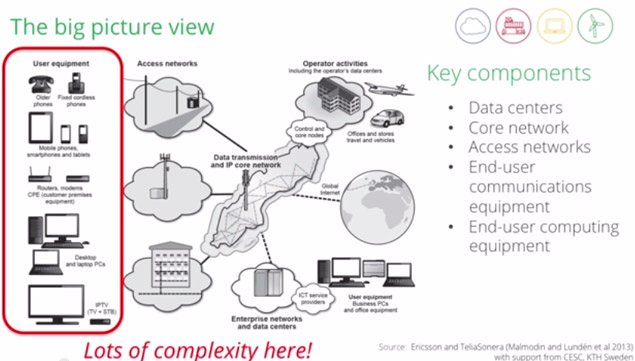
Source: Jon Koomey.
- End-user equipment (computers, tablets, laptops, routers)
- Data centres (that store and host web pages)
- Access networks (the wiring and antennas that carry data)
OK, so what is the environmental impact of the internet?
The first thing that emerges after surveying various sources is that nobody knows for sure. In 2010, The Guardian came up with the figure of 300 million tonnes of C02 per year, “as much as all the coal, oil and gas burned in Turkey or Poland in one year.” A controversial article entitled “Power, Pollution and the Internet” in The New York Times put the figure at 30 billion watts of electricity in 2011, “roughly equivalent to the output of 30 nuclear power plants”. And according to Gartner consultants, the internet was responsible for 2% of global emissions in 2007, outstripping the carbon footprint of the aviation industry. A more recent study by the Melbourne-based research centre CEET in 2013 estimated that the telecommunications industry as a whole emits 830 million tonnes of carbon dioxide a year, and that the energy demands of the internet could double by 2020.
The CEET reports that the internet now accounts for 1.5% to 2% of the world’s energy consumption, which means that if the internet were a country it would rank as the fifth largest for energy consumption. Jon Koomey estimates that the direct electricity use of all the elements that make up the internet is probably around 10% of total electricity consumption, but he emphasises that it’s very difficult to calculate exact figures. “You can use a computer to play videogames or write a text and not be online, and this energy use is often counted as part of the internet even though it isn’t actually the case.”
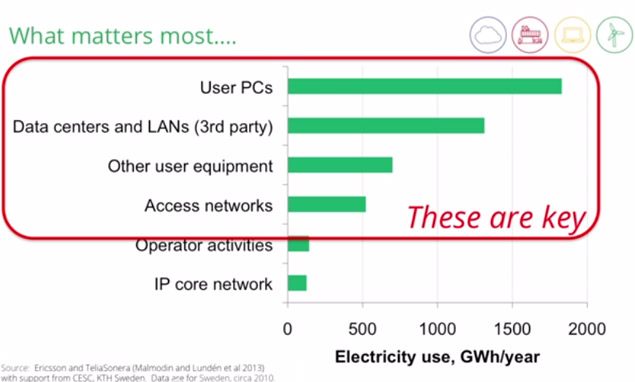
Source: Jon Koomey.
If the internet is virtual, what causes its environmental impact?
Unlike a car that emits fuel through its exhaust pipe, it is difficult to visualise the environmental impact of the net. Its carbon footprint is mainly a result of the power required to keep its infrastructure running. Mobile phone antennas, the devices we use to access the internet, and data centres all require enormous amounts of electricity. This electricity can come from renewable sources, but it often does not. For example, in its report “How Clean is Your Cloud?” Greenpeace found that 70% per cent of the 400,000 mobile phone antennas in India don’t have access to reliable electricity sources, and diesel-powered generators are used to make up for the inadequate power supply. The big data centres in Western countries also rely on back-up diesel generators that kick into action in the event of power cuts.
Why do data centres consume so much electricity?
Data centres are the second most power-hungry elements of the internet, after devices. To get an idea of the energy needs of data centres, Facebook is building one in Prineville, Oregon that will consume around 78 megawatts of electricity, equal to around 64,000 homes.
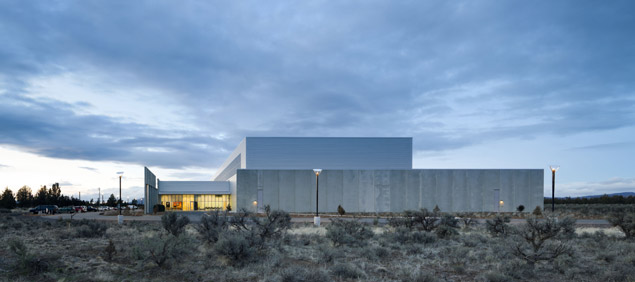
Prineville Data Centre. Source: Facebook.
Even so, many experts believe that data centres are the most efficient way of keeping the internet running, given that centralizing servers in a single location makes it possible to harness synergies and minimise electricity use. “One of the advantages of the cloud is that it allows a much greater concentration of computing and processing power with less servers, which always translates to energy saving. But the only way to reduce pollution is to use renewable energy sources, as well as improving energy efficiency,” explains David Carrero Fernández-Balillo, systems expert and Country Manager de Stackscale Spain.

Facebook servers. Source: Facebook.
If data centres are more efficient, where does the environmental problem come from?
The problem comes from the energy sources that keep the data centres running. At present, most data centres work with energy companies that rely on coal or nuclear power stations to generate electricity.
The report “How Clean is Your Cloud?” found that 55.1% of the electricity used by Apple servers is generated by coal plants, as is 49.7% of the energy used by IBM servers, and 39.4% in the case of Facebook servers. These considerable figures entail thousands of tonnes of carbon dioxide emitted into the atmosphere and the dirty air that goes with it.
Are the big corporations doing anything about it?
Quite a number of steps are being taken. In March 2013, Apple announced that all of its server centres now work with renewable energy, even though this announcement is a bit misleading as part of this target is being achieved through the purchase of carbon credits to offset the nuclear and coal-fuelled electricity used by some of its centres. The company has also built two solar energy plants in Maiden (North Carolina) to meet the needs of its server plants in the area. In addition, it is building a data centre in Prineville, Oregon, that will run on a mix of solar, hydroelectric, wind and geothermic energy.
Meanwhile, Facebook, is building a data centre in Iowa that will run entirely on wind power, which is expected to open in 2015. The company has set itself the target of powering its data centres on 25% renewable energy by 2015. In 2011, Facebook launched the Open Compute Project, an initiative through which to share its data centre management information and know-how in order to encourage industry best practices and help others to maximise their efficiency.
Google has also launched several initiatives designed to boost its environmental transparency. In response to growing media interest and to lobbying by environmental organisations like Greenpeace, the company decided to invite a journalist from Wired to visit one of its centres. Other transparency measures include the creation of a section on its website dedicated to its data centres and a commitment to achieving carbon neutral data centres.
“Google’s servers refresh 20 billion pages a day, process over 100 billion search queries a month, provide email for 425 million Gmail users and process 72 hours of video uploaded per minute to YouTube. And yet we’re able to do all that work with relatively little energy, compared to other industries. Data centres are responsible for between 1.1 and 1.5 percent of global energy use (compare that to transportation at 25 percent), and Google’s data centres are less than a percent of that. It’s a testament to the almost unimaginable improvements in computing power per watt that Moore’s Law has brought us over the past decades. Searching virtually all the world’s online information for a billion users with just 0.01 percent of global energy use illustrates how much less energy it takes to move electrons (information) than atoms (physical things),” writes Urs Hölze, senior vice president for technical infrastructure at Google, as part of a debate on the New York Times website.
All of these corporations have something in common: they invest millions of dollars in building their own infrastructure in order to minimise electricity consumption and reduce costs. The problem, Koomey says, is that many other non-technology companies also have their own infrastructure, and prefer to prioritise operational issues over efficiency. “Just adopting good practices will save at least 50% of data centre energy use, but many companies are failing to do so,” he says.
Why is Greenpeace so interested in this issue?
Greenpeace has focused on drawing attention to the many data centres that are still powered by dirty energy sources such as coal and nuclear plants. The environmental organisation’s lobbying has sparked debate between society and the companies that make up this industry.
Gary Cook, IT analyst at Greenpeace, believes that the problem lies in digital sector priorities. The industry is at a crossroads and has to choose between following in the footsteps of the polluting companies of the past, or being trailblazers of sustainability.
“Unfortunately, as Greenpeace highlighted in a report this year, ‘How Clean is Your Cloud?’ most Internet companies are choosing the quick and dirty path, expanding rapidly without considering how their energy choices impact society. As a result, they are powering the 21st-century data centres that are the engine of the Internet economy with 19th- and 20th-century coal and nuclear power,” said Cook in the debate on the New York Times website.
By way of example, he said that all the big internet corporations in the United States work with Duke Energy in North Carolina, which is not expected to generate even 4% of its electricity from renewable sources until 2030. Greenpeace acknowledges the commitments of companies like Facebook and Google, but says there is still a long way to go.
So what’s the deal? Wasn’t the internet supposed to be much more environmentally friendly than the analogue world it was replacing?
It is, and it will continue to be so. From 2000 to 2006 total internet traffic rose by 32,000,000%, while total energy consumption only increased by 200% during the same period says Jon Koomey. “An impressive achievement.”
“And we shouldn’t forget that IT improves the efficiency of non-digital industries, which account for 90% of the world’s electricity use,” adds the Stanford scientist.
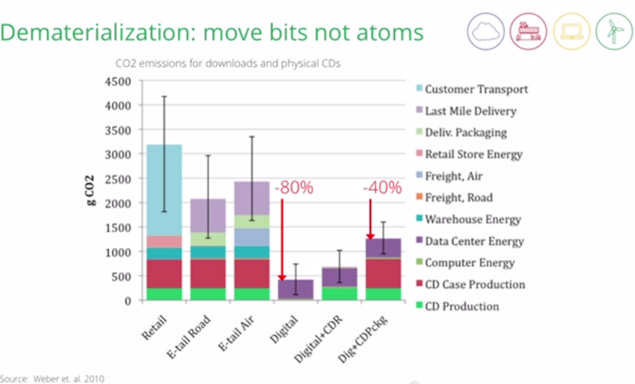
Source: Jon Koomey.
What can I do to reduce the carbon footprint of my internet use?
In this immense digital infrastructure, where an individual counts for little or nothing in the overall scheme of things, one of the best ways to improve a website’s energy efficiency is by optimising its programming and design. A page with clean code and a balanced design will load more quickly than a site full of banners, pop-ups, large photos and external programmes that slow it down.
“At 1.4 MB, today’s average page is 15 times larger than it was 10 years ago, primarily due to images (881kB) and script (225kB) (…) This average page also makes more than 100 HTTP requests,” explains James Christie in a study of sustainable design published in A List is a Part.
Every visit to a website has a carbon footprint. Harvard University physicist Alex Wissner-Gross calculates that viewing a web page generates about 0.02g of CO2 per second, which goes up to about 0.03 g when viewing a website with complex images, animations or videos. “So when you are sitting in London viewing a website hosted in California, there are power plants on at least two continents actively pumping carbon dioxide into the atmosphere in order for you to watch that video or read that online newspaper…” he says. There are also simple steps you can take, as David Carrero explains, like “ensuring that the equipment we buy is appropriate to our needs but does not exceed them, in order to optimise energy use, and always switching off devices once we’re done, even the ADSL router at night.”
How much energy can I save by optimising my website? The case of Meneame.net…
With an average of 350,000 to 400,000 visits a day and 40 million page visits a month, Menéame is one of the Iberian Peninsula’s most visited sites. “We’ve measured our electricity use very carefully right from the start, for two reasons. Firstly because we needed to: the less you consume, the lower your electricity costs. Secondly, that’s our style. Ricardo Gali has a PhD in Computing, and one of his obsessions is energy saving systems for loading pages,” says Benjamí Villoslada, who co-founded the social news aggregator with Gall in 2005.
They put so much effort into energy efficiency that Villoslada believes a badly designed website would consume four times as much as Menéame in order to perform the same tasks. “You save money and society as a whole saves time and money. Everybody wins by making things simpler.” The steps they take to boost efficiency include constantly optimising the website database, keeping the code that runs the page clean and orderly, and making sure that there are no unessential elements in it. “We use a software to prevent bots. When we detect that an IP is making more than 40 requests per second, we block it.”
Menéame uses the Amazon Web Services server in Ireland to run the website. “It lets us pay for the actual consumption we need at any given moment. You need to have solid knowledge to work with them, but the set-up is good. There may be some more environmentally friendly places around, but if they are badly designed you can end up using more resources than you do with an efficient site like Amazon,” adds Villoslada.
Do any data centres run on 100% renewable energy?
Iceland is positioning itself as the location of choice for companies interested in minimising the environmental impact of their data centres. Its volcanic landscape means it has plentiful, reliable renewable energy, and 72% of the electricity generated in the country comes from hydroelectric and geothermic sources.
The company Verne Global was founded in 2007 and runs two data centres in the country, with clients that include companies such as BMW, Colt and Securitas. As well as clean energy, on average Iceland generates electricity at a quarter of the cost of other industrialised countries.
In Sweden, renewable sources account for 60% of the energy generated, a fact that Facebook took into account when it decided to set up a data centre in Lulea, a town some 100 kilometres from the Arctic Circle. It is a “colossus that helps Facebook process 350 million photographs, 4.5 billion “likes” and 10 billion messages a day,” according to Bloomberg Businessweek.
In this remote town, Facebook has hydroelectric power near at hand, and its premises have also been designed to take advantage of the freezing Lapland winter air to cool its servers without the need for air conditioning systems.
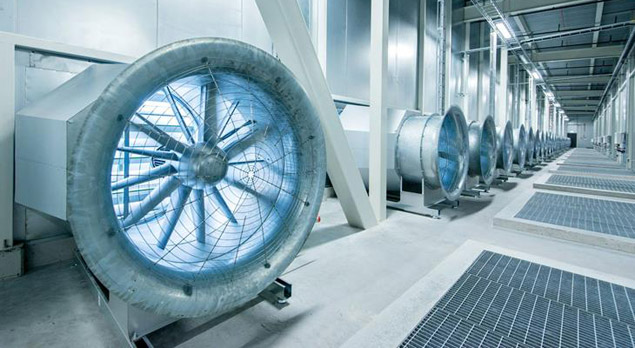
uleå FB Data Center – Cooling Fans. Source: Facebook.
What about the data centres in Spain and Catalonia?
“In Spain, over 1,800 companies are registered as ‘data processing and computing centres’, but most of them do not have their own data centres. And vice versa: many companies that own data centres are not included in this group. We do, however, have a reasonably comprehensive list of Spanish companies that offer their data centre facilities to third parties” says Jaime Fernández Gómez, Head of Infrastructure at Acens.
“Datacenter Dynamics estimates that data centres around the world were consuming over 40 gigawatts in late 2013, a figure that is expected to go up to 50 gigawatts by late 2016. An average nuclear power station produces around 1 gigawatt. If we look at the percentage of the world’s data centres that are located in Spain, we can estimate that between 1% and 2% of this energy is consumed in data centres here,” he adds.
In January 2003, IBM announced that it would soon open a cloud centre in Cerdanyola del Vallés, in the province of Barcelona. Its first client is the Generalitat de Catalunya, which is centralising its Health, Welfare and Family data at the centre.
So should we be worried?
The problem of the internet’s energy consumption is a problem that it shares with the rest of humanity. We have not yet found a system that allows us to meet our needs without relying at least partly on fossil fuels. When we do so, the internet will be a key element.
As citizens, understanding that the internet is neither infinite nor invisible is a good place to start. It isn’t enough to demand that companies use cleaner energy sources to keep their infrastructure running. Everybody can contribute by creating more lightweight website designs, not leaving their devices on standby, and buying equipment that meets but does not exceed their needs. “Computer efficiency has steadily doubled every year” over the past 60 years, says Koomey, a pattern that shows that the internet is part of the solution.

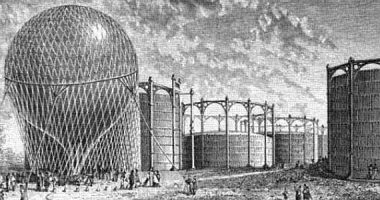



Beatriz Tesier | 10 December 2015
Muy interesante, tendríamos que ser todos conocedores sobre el tema.
Equip CCCB LAB | 11 December 2015
Cierto. Gracias!
Sulfen | 24 January 2016
This is a topic that few people know about that should be more common knowledge. We all have a device that connects to the Internet and we all are equally responsible so why shouldn’t we all know? Hopefully this becomes a talking point in the next few years as the Internet continues to boom as it reaches more third world countries.
Leave a comment